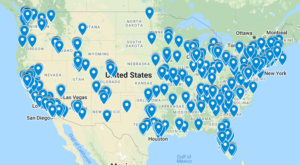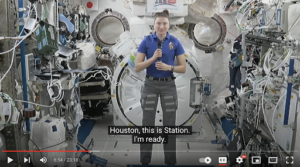
1,520 attendees. 104 speakers. Live endorsement by the Secretary of Energy. A livestream from space. By all measures, the National Energy Storage Summit, led by Berkeley Lab on March 8-9, was a resounding success.
Such an endeavor was the work of many hands over many months. A brainchild of Lab Director Mike Witherell last spring, the intent was to reinforce Berkeley Lab’s role as a serious national energy storage player, highlight the Lab’s new Energy Storage Center which was established in the fall of 2020, and shine a spotlight on the depth and breadth of exciting energy storage work taking place at the Lab. An important goal was to bring together and encourage collaborations across many parts of the energy storage ecosystem, including research and academic institutions, industry, policymakers, finance, government, and communities, to catalyze solutions and partnerships around specific challenges to America’s energy storage future.
Participation from a Diverse Group of National Leaders
A notable achievement was the diversity of participation: the largest chunk of attendees were from industry with over 850 at final count, with over 700 from government and the national labs, over 400 from academia, and about 70 each from the finance/venture capital sector, utilities, and non-governmental organizations. Organizers also spent great effort on ensuring a diverse slate of speakers. VIP speakers included:
- Elected Officials: Senator Padilla (CA), Representative Foster (IL), Representative Curtis (UT), and Representative Takano (CA)
- White House leadership from the National Economic Council and the Office of Science & Technology Policy
- DOE leadership: Under Secretary of Science and Innovation Geri Richmond and leadership from Justice40, Advanced Manufacturing Office, Loan Programs Office, Vehicle Technologies Office, Building Technologies Office, Energy Storage Grand Challenge, and the new Joint Office of Energy and Transportation
- CA leadership: California Energy Commission Chair Hochschild, Assemblymember Eduardo Garcia, and Lithium Valley Commission Chair Silvia Paz
- Industry leadership from Albemarle, Berkshire Hathaway Energy, Cuberg, Duracell, LGChem Power, Northvolt, Malta, Microsoft, and Quantumscape
- Other government and non-government leadership: the Department of Defense Chief Science Officer, an Assistant Secretary from the Department of Commerce, and representation from the the Government of Canada, California Independent System Operator (CAISO), European Battery Alliance, Electric Power Research Institute (EPRI), Federal Energy Regulatory Commission (FERC), Hydrogen Council, Long Duration Energy Storage Association of California (LDESAC), North Carolina Utilities Commission, NAATBatt, and New York Battery and Energy Storage Technology (NY-BEST) Consortium.

Two Days of Convening and Connecting
Energy storage is critical in the fight against climate change. It’s a major area of focus for the Department of Energy (DOE) because of its importance as a solution for energy-efficient transportation, buildings, industry, the evolving grid, and resilience. Part of the challenge is to build up battery production as a major domestic manufacturing effort, not least because of the implications to both national and economic security. “Accelerating the science, technology, policy, and markets in the energy storage sector requires an all hands on deck approach,” said Noël Bakhtian, Executive Director of the Lab’s Energy Storage Center. “We wanted to convene the diverse players around the two major themes of the Center, engage them in this national event using some innovative mechanisms, and jumpstart new ideas and collaborations to accelerate our collective impact.”
The first day of the two-day Summit focused on revolutionizing a domestic battery ecosystem in the U.S., and moving us from an importer to exporter. It featured a fireside chat hosted by Noël with DOE Secretary of Energy Jennifer Granholm and CEO of General Motors Mary Barra. This was followed by panel discussions across the value chain, from building out the domestic lithium resource, materials and processing, leveraging manufacturing innovations, and building gigafactories for next-gen batteries.
A highlight of the first day was a “field trip” to the International Space Station and an up-close conversation with NASA astronaut Kayla Barron, who talked about the space stations’ energy storage technology (23:18 video recording on YouTube). This segment also announced the new national virtual field trip series being launched by the Energy Storage Center in partnership with SLAC National Accelerator Lab, Exploring the World Unplugged: the Secret Life of Energy Storage.

The Summit participants collectively discussed the National Blueprint for Lithium Batteries and made recommendations for how to advance near-term goals. This discussion will inform the post-Summit report. In addition, energy justice was an integral part of the day’s sessions, and was the theme for the virtual happy hour conversations facilitated by Energy Justice Ambassadors.
Day 2 focused on accelerating discovery to deployment of energy storage for decarbonization. Summit organizers welcomed the Lab’s annual Bay Area Battery Summit partners to the conference, including New Energy Nexus, SLAC National Accelerator Laboratory, and Lawrence Livermore National Lab. In addition to keynote speeches, expert “lightning talks” presented the challenges and opportunities in each of the energy sectors, while a lively Pitchfest allowed 15 innovative participants to share their ideas with conference attendees. Collaboration Cycles offered opportunities for attendees to meet one-on-one with others or to participate in roundtable discussions on a number of Berkeley Lab-centric storage topics, including battery recycling, artificial intelligence and machine learning, hydrogen, Lithium Valley, long duration storage, and user facilities, with hosts hailing from many national labs. Day 2 also included content on policy—both legislative and regulatory—with speakers giving insights from both federal and state perspectives.
Engaging in Energy Storage
Summit participants were highly engaged in the activities and in connecting with each other. As evidence, participants in total amassed 23,000 raffle prize points, earned through attending sessions, setting up meetings, joining brainstorms or the happy hour, submitting content for the Showcase, proposing an abstract for Pitchfest, or engaging on social media. Eight raffle prize winners can look forward to meeting with Nobel Prize Laureates or DOE senior leaders, enjoying private Lab tours, or receiving swag bags, among other prizes.
In addition to the two-day lineup, the Summit website also featured a virtual Showcase that highlighted participant expertise, capabilities (e.g. user facilities, testbeds, research centers, equipment), and licensable inventions, with the intention of breaking down silos across the energy storage ecosystem and catalyzing new partnerships.
In fact, the engagement continues. A $20,000 Collaboration Seed Fund is available to help launch collaborative ideas that stemmed from the Summit. As of the end of March, more than 845 people have viewed the recorded content post-Summit (the recordings will also be added to the Energy Storage Center website). And in future, Berkeley Lab’s Energy Storage Center will collaborate with others across the ecosystem to host smaller, more specialized workshops.
Noël noted that to pull off an event like the National Energy Storage Summit required passion and commitment from a great many people. “My heartfelt thanks goes to the Lab committees and teams—over 100 people across Berkeley Lab—who worked tirelessly behind the scenes to raise the Lab’s profile in this critical research area,” she said.

